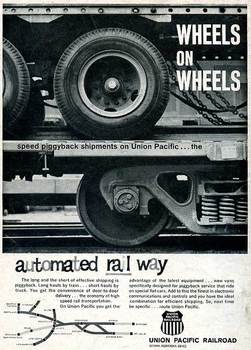Speed Lettering 05 [Column_Letters & Figures]
 : UP ad appeared in Jul 1965 issue of Trains
: UP ad appeared in Jul 1965 issue of TrainsIndeed, the Rio Grande was inferior in speed to UP or ATSF. So, we can say that the flying (leaning forward) logo was suitable because of its lack of speed.
Anyhow, the speed of italic fonts and the speed of the train donユt fit. This phenomenon can be grasped as the existence of the difference between the label and the contents. The difference may be the reason why the "Speed Lettering" lived relatively short.
I didn't mention here about the conflict between the direction of writing/reading and the move. "Rio Grande" would appear as "ednarG oiR". Thus there are difficulties in designing the letters on the sides of railroad equipment.
The "Speed Lettering" lived relatively short except the Rio Grande. Now, I wonder how long the BNSF and NS logos will live.
確かに、ロッキーの山塊を貫くRio Grandeは、それを迂回するUPやATSFに比べ、速度で劣勢にあった。つまり、比較的速度が遅かった。したがって、Rio Grandeの前傾書体によるロゴは、列車の速度に似合っているといえる。あえていえば、自身が持ち合わせていない要素をロゴのデザインにしている。
仮に、イタリック書体をロゴに導入した時期にイタリック書体が速度を要素として持っていたなら、各鉄道は、自身が持ち合わせていないまたは失ってしまった要素を、ロゴに埋め込んだことになる。
いずれにせよ、イタリック書体を用いるロゴが車体に記される場合、文字列の速度と列車の速度は方向にかかわらず合致しない。これは商品とその表記の間に差があることとしてとらえられる。Rio Grandeのロゴを除けば、斜体ロゴはいずれも20年前後で消滅している。差があることが、イタリック書体を用いるロゴが比較的短命である原因なのかもしれない。
ここでは触れなかったが、文字を読む方向とそれが記されたモノの方向も、常にうまく行くとは限らない。京都・出町柳行きで後退していた京阪特急の文字は、大阪・淀屋橋行きでは前傾する。出町柳行き「テレビカー」は淀屋橋行き「ーカビレテ」とも読める。このように、動くモノに記す文字のデザインには、困難さが付きまとう。
さて、イタリック書体を用いるBNSF・NSのロゴは永く続くだろうか?
2010-05-24 14:56
コメント(0)
トラックバック(0)




コメント 0